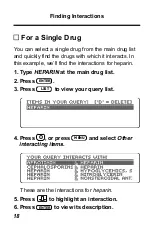
3
This handbook offers a quick guide to possible adverse effects
of drug interactions, with brief recommendations for precaution-
ary measures. References are given to original reports that
provide more complete discussions of each interaction.
This book— lists adverse drug interactions, their mechanisms,
and recommendations for clinical management. These listings
are usually based on clinical reports.
Reports of interactions between more than two drugs are
appearing in the medical literature with increasing frequency.
Where these have been documented, they are noted as
comments under interacting pairs of drugs. Interactions listed
for groups of drugs (such as “cephalosporins” or “antidepres-
sants, tricyclic”) may not have been reported for every drug in
the group; known exceptions to the interaction are noted.
It is not possible to determine the frequency of most interac-
tions. When an interaction is documented by one or two case
reports rather than by clinical studies or reports in many
patients, the year of each report is given as some indication of
frequency.
Omissions—New adverse interactions are continually being
reported; the absence of a listing in this digital book does not
necessarily mean that drugs will not interact when given
concurrently. Drugs for which we have no documented
interactions in people are usually not listed; interactions
extrapolated from animal studies or interactions reported
with related drugs, frequently mentioned in other sources,
such as the manufacturer’s package insert, may therefore
not be included here.
Interactions between general anesthetics and drugs likely to be
administered during surgery, such as autonomic drugs and
Introduction to the HADI





















